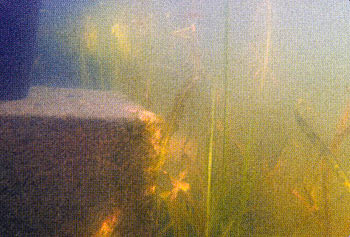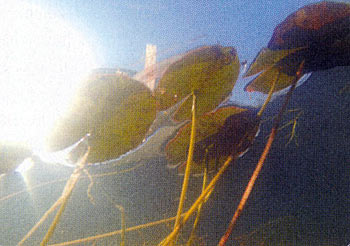
Lakes and ponds are scattered across many a countryside. Anglers often seek trophy fish and spend considerable amounts of time and money to create trophy fisheries. Although it is widely understood in professional circles that multiple strategies need to come together to establish and maintain a trophy fishery, many lake and pond owners struggle to reach their goals. Sure, pond owners understand the basic value of habitat, and know it takes ten pounds of baitfish for a game fish to gain a pound. They often seek the perfect mix of stocking rates, genetics, and water quality to create the best fishery possible, but don't understand the importance of aquatic vegetation management as a crucial element that ties a system together to produce and grow those special fish.
When thinking about what an ideal lake looks like, the image of a clear lake with fishable banks and abundant wildlife often comes to mind. However, when managing a lake for fish production, it is important to take a step back, or in this case, a step into the water, and look at the lake from a different perspective—a fish's perspective.

Fisheries tend to be the most productive when the waterbody contains 20-25% cover and/or habitat. For trophy fisheries, oftentimes 10-15% should be submerged structures such as rocks, cedar trees, and artificial habitat, while the other 10-15% of the cover should be in the form of beneficial aquatic vegetation.
Not all aquatic plants are good for a fishery. Often, unacceptable aquatic vegetation are those fast growing invasives that are hard to control through mechanical, chemical, and biological methods. Without any control, these species oftentimes overtake the waterbody, which disrupts the pond's aesthetics and interferes with both fish behavior and the angler's fishing experience. A few examples of unwanted species include duckweed, mosquito fern, bushy pondweed, hydrilla, and bladderwort.
Beneficial aquatic vegetation includes both submerged and emergent native, non-invasive species. A few examples of beneficial plants are pickerelweed (arrowhead), American pondweed, and water willow. There are quite a few more, depending where your pond resides. One important aspect of beneficial plants for trophy lake management is to provide young-of-year fish refuge access from predatory fish.
The submerged portion of plants should contain enough open space between plants and branches to allow small fish to swim through, while not overcrowding the waterbody with too much density or mass. The emergent aspect of beneficial plants provides shade for fish, as well as cover from predators beyond the lake such as birds.
Increasing refuge for forage fish ultimately increases forage fish populations by reducing predation rates, while allowing small fish to grow into larger morsels that are more beneficial to your game fish. Additionally, vegetation serves as habitat for emerging aquatic insects as they molt into their adult stage, which then become a primary food source for forage fish.

Aside from improving lake habitat and increasing forage fish populations, properly managed aquatic vegetation has other benefits. Through healthy management, angling success can be improved by forming fishing lanes within the beneficial plants. Fishing lanes can be formed by proper lake or pond construction, and by using herbicide treatments to manage vegetation. Large fish tend to congregate along the edge of vegetation, cruising for food, or simply staging in the shade. As a result, anglers typically have improved fishing success when targeting these aquatic plant edges.
Management is important for nearly all species of aquatic vegetation. Herbicide treatments, although sometimes costly, may be necessary to maintain the proper level of control. If unmanaged, aquatic vegetation will typically overwhelm all shallow areas within a waterbody. Once the vegetation becomes dominant, it begins to adversely affect the fishery by disrupting predator-prey interactions, diminishing water quality, and disrupting angling efforts.
There is a risk in tolerating invasive vegetation. If it is left unmanaged, it will oftentimes have a detrimental impact on the fishery within one or two years. When possible, invasive vegetation species should be eradicated and native species encouraged. In general, when compared to invasive species, native species can have a better influence on the fishery and are more cost effective to manage over time.
Properly managed aquatic vegetation also promotes ideal oxygen levels and the fishery's overall production. If fish are stressed due to low oxygen levels, fish growth slows and they become more susceptible to diseases and bacteria.
One of the best ways to limit vegetation growth, and reduce the management effort required, is through proper lake construction. Most aquatic vegetation is unable to grow in water deeper than eight feet, because sunlight is typically unable to reach the bottom sediment. Without sunlight, vegetation is unable to germinate, and as result limits plant growth. When possible, waterbodies should be built with vegetation growth in mind, and remember that over time, sediment builds in ponds, reducing water depth. To minimize vegetation overgrowth as the pond or lake ages, it is important to provide sufficient depth to account for sedimentation over the years.
Not all ponds and lakes are designed to handle submersed species of vegetation, so make sure your pond's depth, the vegetation species present, and your management strategy line up with your goals and budget. As you work to establish or maintain aquatic vegetation in your pond or lake, it is important to pinpoint the areas of your waterbody where vegetation is
likely to grow. Then, with that knowledge, you can begin to develop a good management plan.
Unmanaged vegetation can become a hassle and a setback, but if properly established and managed, aquatic vegetation can help advance your fishery's potential.
Here are your main take-home points for working with nature and her underwater plant offerings. First, if you are building a lake or pond, minimize shallow water with thoughtful slopes to prevent vegetation from creeping beyond your designated boundaries. Second, if you have an existing pond, be sure to prevent or eliminate exotic or invasive plants. That means you need to learn what those are for your area.
Third, a pond covered with 10-15% of healthy stands of both emerged and submersed preferred native plants provides habitat for your tiniest fish, creates edge cover for anglers, and sets your pond or lake on a trajectory to become a successful trophy fishery.
Reprinted with permission from Pond Boss Magazine



